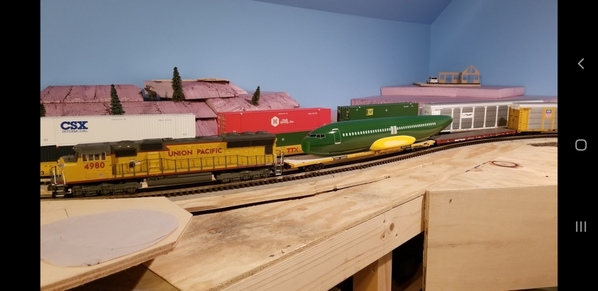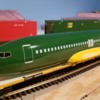Earlier this year I bought a couple 60' foot flat cars from Atlas. At the time they were by far the biggest rolling stock that I owned. I ran them on the layout and loved how detailed they were. After a while in thought that they needed a load to spice them up. I started looking on Google for modern flat car loads and I stumbled upon the Boeing 737 loads. I had never realized that Boeing was shipping fuselages across the country by train. Spirit AeroSystems builds the fuselages in Wichita, Kansas and ships them to Boeing in Renton, Washington using BNSF.
I started looking to see if anybody was selling these behemoths. I found a lot of HO and N Scale modelers making them, but no one makes them in O Scale. This got me thinking if no one is making then I going to have to build it myself. I started looking for 3D files of 737s. This proved to be just as hard as finding someone that would sell me one. I found a couple of people who posted their files on Shapeways but, they were all in HO or N again, no O.
I knew if I just had the file, I could easily Scale it up to the correct dimensions. Sadly, the way Shapeways works is that sellers upload models and the seller has Shapeways print and ship the parts to the buyer. As a buyer you can't get the files and use them for yourself. This is very different from the way most of 3D printer community works. Most times files are posted online for free on site like Thingiverse, and MyMiniFactory. This has led to a huge boom in idea sharing and amazing models. I would argue that it’s a huge reason that 3D printers are so popular today.
However, I digress, I did end up finding a file on a site call grabCAD. A user named "Ben Blecha" had made an HO 737-800 fuselage and posted it there. I downloaded the file and got to work on modifying it.
The first thing I needed to do was Scale the model to the correct size. According to the NMRA standard HO Scale is 1:87.1 and O Scale is 1:48. To find the scale factor I used this equation 48/87.1 = 0.5511. All I need to do was scale the model in cad by 0.5511. I checked that I did this correctly by looking up the specs of the real 737-800 which is 130 feet according to Google. I found that my math was pretty close making considering my airplane was missing a tail fin and chuck of its nose. The O Scale fuselage end up being a whopping 30 inches. To put that into perspective Lionel's Big Boy is 32 inches with tender.
My 3D printer is nowhere near big enough to print this airplane out in one go. I decided that I need to break up the model into smaller pieces. I'm using an Ender 3 to print all my stuff and it has a print volume of 8.6" wide, 8.6" long, and 9.8" tall. I decided to cut the model into 7" long sections which gave me five sections to print. I could have gone taller but by making the cuts shorter people with smaller printers could also give this print a try.
Once I was done cutting the model, I figured that I should create some short of key in between the cuts so that when I went to assembly the model they would line up perfectly. I created circle shaped embossment on one section and the other section I cut away the material kind of like the pins and holes on a Lego brick. I also add 0.005" of tolerance between the pin and hole so that I could fit them together easily and also because 3D printer aren't prefect and won't also hit perfect dimensions.
At this point I was ready to move on the slicing the model. Slicing is how you tell your printer what you what to make. 3D printers are kind of "dumb machines" meaning they don't really think for themselves. 3D printers just do exactly what they are told. You tell them what to do by feeding them a programing language called g-code. The slicing software writes the g-code for you cutting your model into a series of thin layers. Once the software is done slicing, it creates a file that you can send to your printer.
Printing the 737 required high resolution (how thin each layer is) which increases your print time. It ended up taking over 6 and half days to finish the whole print. I ended up printing each section separately instead of printing them all at once which meant that each section took about a day and half. It didn't really dawn on me how big this was going to be until I started to assembly it. It was bigger than the 60' flat car that started with, so much bigger in fact that I decided to go with the proto typical 89' flat car. Not to mention this load brings a whole new meaning to "swing out". It hangs a good 6" off the end of the flat car and hits other trains on my double main line.
I am very happy how this project has turn out so far. I still have a lot to do with sand and painting before it done. I'm glade take I was able to use so many of my skill to make something that nobody else had, but now that anyone who wants one can make their own. I'm posting the files on Thingiverse "link here". For those of you brave enough to.










